Page 53 of 469
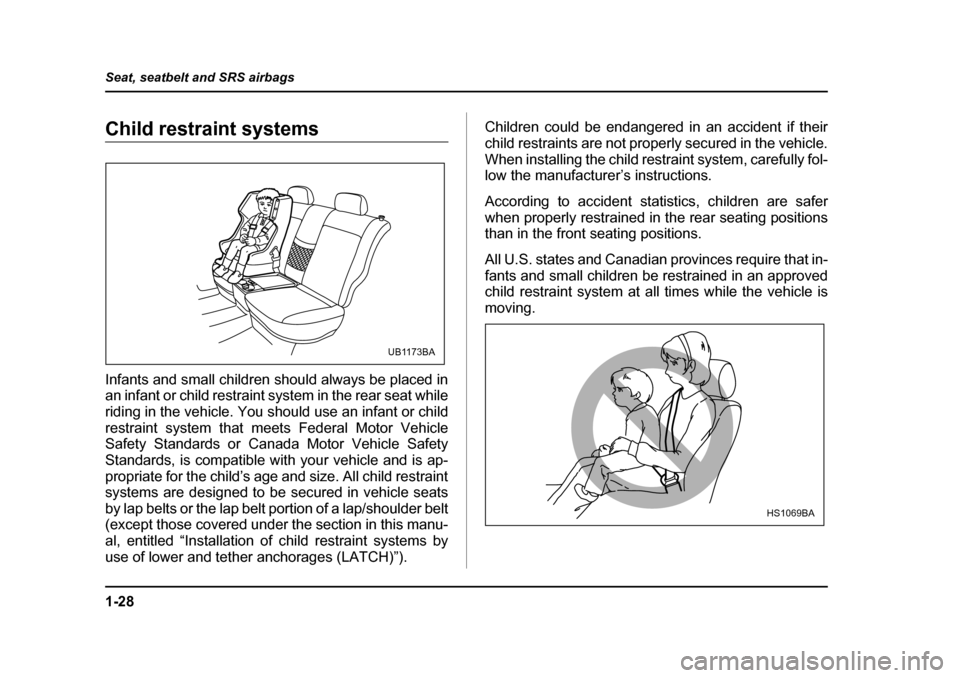
1-28
Seat, seatbelt and SRS airbags
Child restraint systems
Infants and small children should always be placed in
an infant or child restraint system in the rear seat while
riding in the vehicle. You should use an infant or child
restraint system that meets Federal Motor Vehicle
Safety Standards or Canada Motor Vehicle Safety
Standards, is compatible with your vehicle and is ap-
propriate for the child’s age and size. All child restraint
systems are designed to be secured in vehicle seats
by lap belts or the lap belt portion of a lap/shoulder belt
(except those covered under the section in this manu-
al, entitled “Installation of child restraint systems by
use of lower and tether anchorages (LATCH)”).
Children could be endangered in an accident if their
child restraints are not properly secured in the vehicle.When installing the child restraint system, carefully fol-
low the manufacturer’s instructions.
According to accident statistics, children are safer
when properly restrained in the rear seating positions
than in the front seating positions.
All U.S. states and Canadian provinces require that in-
fants and small children be restrained in an approved
child restraint system at all times while the vehicle is
moving.
UB1173BA
HS1069BA
Page 54 of 469
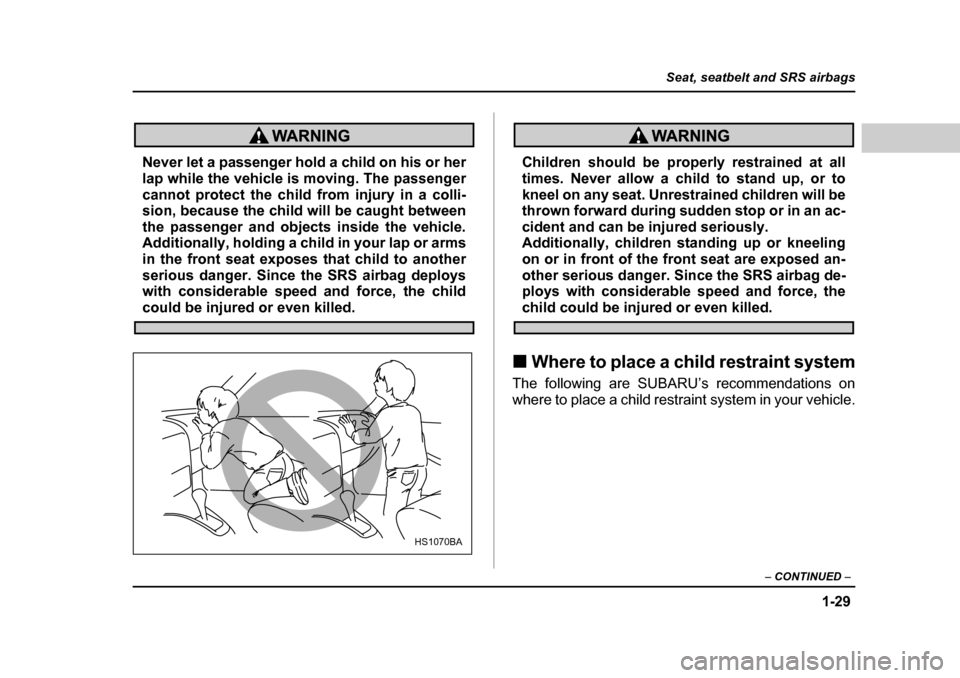
1-29
Seat, seatbelt and SRS airbags
– CONTINUED –
Never let a passenger hold a child on his or her
lap while the vehicle is moving. The passenger
cannot protect the child from injury in a colli-
sion, because the child will be caught between
the passenger and objects inside the vehicle.
Additionally, holding a child in your lap or arms
in the front seat exposes that child to another
serious danger. Since the SRS airbag deploys
with considerable speed and force, the child
could be injured or even killed.
Children should be properly restrained at all
times. Never allow a child to stand up, or to
kneel on any seat. Unrestrained children will be
thrown forward during sudden stop or in an ac-
cident and can be injured seriously.
Additionally, children standing up or kneeling
on or in front of the front seat are exposed an-
other serious danger. Since the SRS airbag de-
ploys with considerable speed and force, the
child could be injured or even killed.
�„ Where to place a child restraint system
The following are SUBARU’s recommendations on
where to place a child restraint system in your vehicle.
HS1070BA
Page 55 of 469
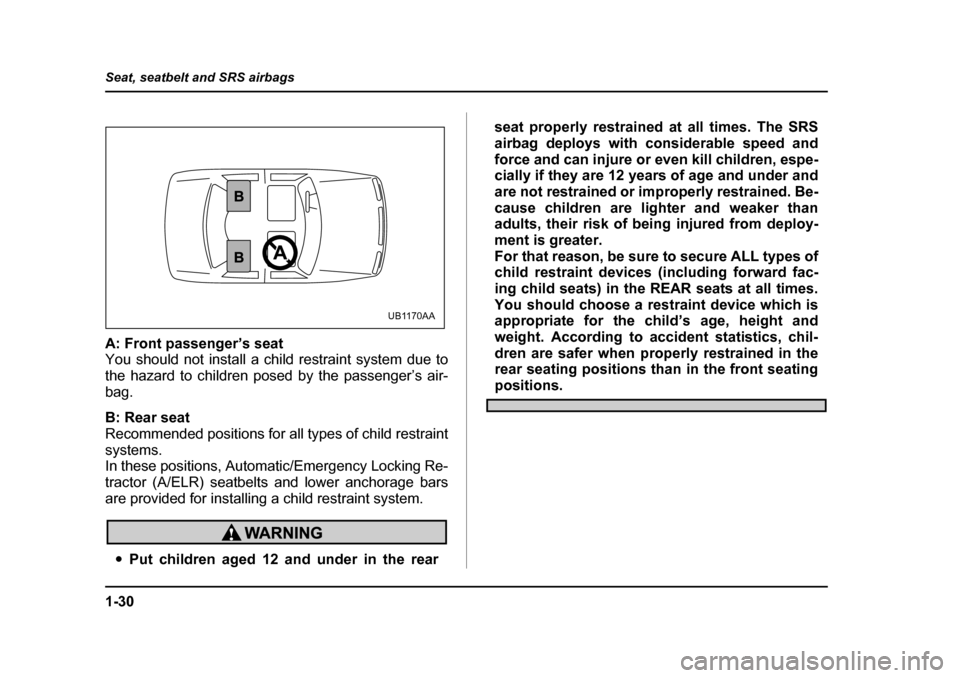
1-30
Seat, seatbelt and SRS airbags
A: Front passenger’s seat
You should not install a child restraint system due to
the hazard to children posed by the passenger’s air-
bag.
B: Rear seat
Recommended positions for all types of child restraint
systems.
In these positions, Automatic/Emergency Locking Re-
tractor (A/ELR) seatbelts and lower anchorage bars
are provided for installing a child restraint system.
�y
Put children aged 12 and under in the rear seat properly restrained at all times. The SRS
airbag deploys with considerable speed and
force and can injure or even kill children, espe-
cially if they are 12 years of age and under and
are not restrained or improperly restrained. Be-
cause children are lighter and weaker than
adults, their risk of being injured from deploy-
ment is greater.
For that reason, be sure to secure ALL types of
child restraint devices (including forward fac-
ing child seats) in the REAR seats at all times.
You should choose a restraint device which is
appropriate for the child’s age, height and
weight. According to accident statistics, chil-
dren are safer when properly restrained in the
rear seating positions than in the front seating
positions.
UB1170AA
Page 56 of 469
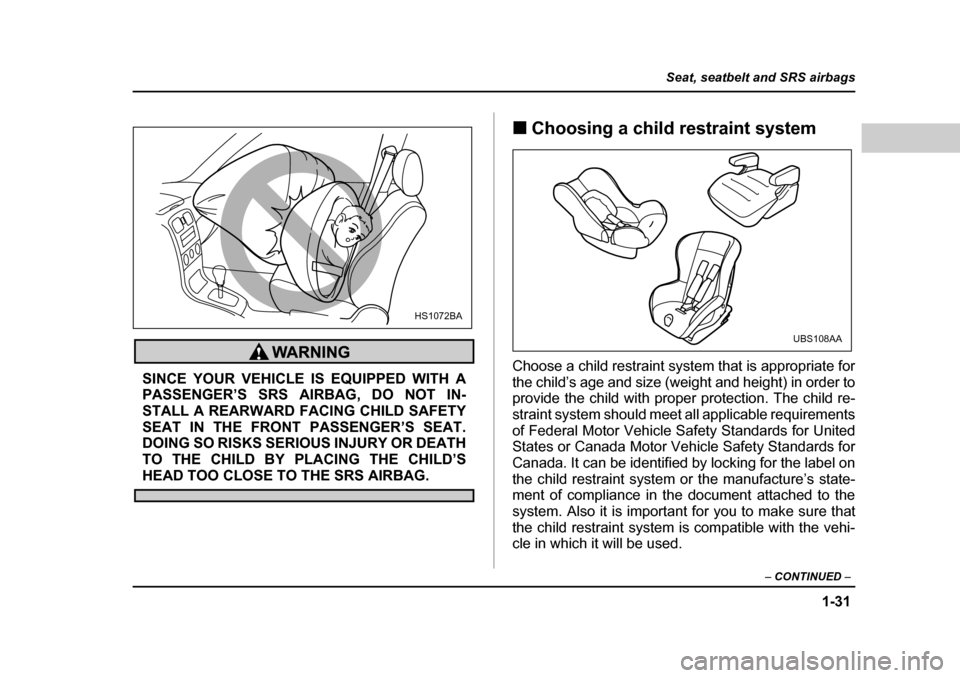
1-31
Seat, seatbelt and SRS airbags
– CONTINUED –
SINCE YOUR VEHICLE IS EQUIPPED WITH A
PASSENGER’S SRS AIRBAG, DO NOT IN-
STALL A REARWARD FACING CHILD SAFETY
SEAT IN THE FRONT PASSENGER’S SEAT.
DOING SO RISKS SERIOUS INJURY OR DEATH
TO THE CHILD BY PLACING THE CHILD’S
HEAD TOO CLOSE TO THE SRS AIRBAG. �„
Choosing a child restraint system
Choose a child restraint system that is appropriate for
the child’s age and size (weight and height) in order to
provide the child with proper protection. The child re-
straint system should meet all applicable requirements
of Federal Motor Vehicle Safety Standards for United
States or Canada Motor Vehicle Safety Standards for
Canada. It can be identified by locking for the label on
the child restraint system or the manufacture’s state-
ment of compliance in the document attached to the
system. Also it is important for you to make sure that
the child restraint system is compatible with the vehi-
cle in which it will be used.
HS1072BA
UBS108AA
Page 57 of 469
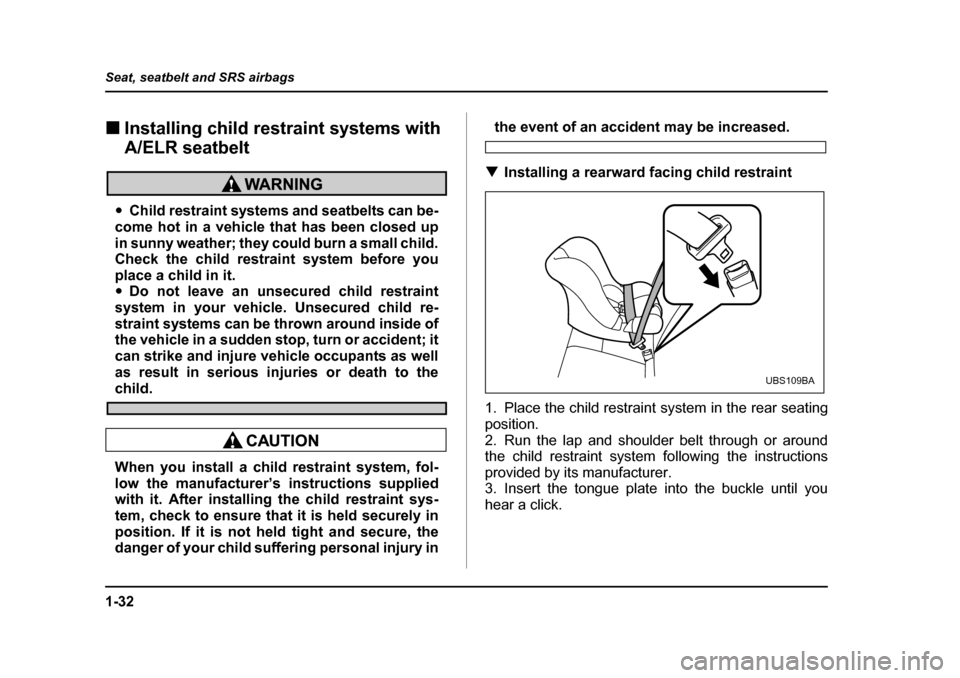
1-32
Seat, seatbelt and SRS airbags
�„
Installing child restraint systems with
A/ELR seatbelt
�yChild restraint systems and seatbelts can be-
come hot in a vehicle that has been closed up
in sunny weather; they could burn a small child.
Check the child restraint system before you
place a child in it. �y Do not leave an unsecured child restraint
system in your vehicle. Unsecured child re-
straint systems can be thrown around inside of
the vehicle in a sudden stop, turn or accident; it
can strike and injure vehicle occupants as well
as result in serious injuries or death to the
child.
When you install a child restraint system, fol-
low the manufacturer’s instructions supplied
with it. After installing the child restraint sys-
tem, check to ensure that it is held securely in
position. If it is not held tight and secure, the
danger of your child suffering personal injury in
the event of an accident may be increased.
�T Installing a rearward facing child restraint
1. Place the child restraint system in the rear seating position.
2. Run the lap and shoulder belt through or around
the child restraint system following the instructions
provided by its manufacturer.
3. Insert the tongue plate into the buckle until you
hear a click.
UBS109BA
Page 58 of 469
1-33
Seat, seatbelt and SRS airbags
– CONTINUED –
4. Take up the slack in the lap belt.
5. Pull out the seatbelt fully from the retractor to
change the retractor over from the Emergency Lock-
ing Retractor (ELR) to the Automatic Locking Retrac-
tor (ALR) function. Then, allow the belt to rewind into
the retractor. As the belt is rewinding, clicks will be
heard which indicate the retractor functions as ALR. 6. Push and pull the child restraint system forward
and from side to side to check if it is firmly secured.
Sometimes a child restraint can be more firmly se-
cured by pushing it down into the seat cushion and
then tightening the seatbelt.
7. Pull at the shoulder portion of the belt to confirm
that it cannot be pulled out (ALR properly functioning).
UBS110BAUBS111BA
Page 59 of 469
1-34
Seat, seatbelt and SRS airbags
8. To remove the child restraint system, press the re-
lease button on the seatbelt buckle and allow the belt
to retract completely. The belt will return to the ELR
mode.
NEVER INSTALL A REARWARD FACING CHILD
SEAT IN THE FRONT PASSENGER’S SEAT.
DOING SO RISKS SERIOUS INJURY OR DEATH
TO THE CHILD BY PLACING THE CHILD’S
HEAD TOO CLOSE TO THE SRS AIRBAG.
NOTE
When the child restraint system is no longer in
use, remove it and restore the ELR function of the
retractor. The function is restored by retracting
the seatbelt fully. �T
Installing forward facing child restraint sys-
tems with seatbelt and tether anchorages
When you install a child restraint system, fol-
low the manufacturer’s instructions supplied
with it. After installing the child restraint sys-
tem, check to ensure that it is held securely in
UG1089BA
UB1148BA
Page 60 of 469
1-35
Seat, seatbelt and SRS airbags
– CONTINUED –
position. If it is not held tight and secure, the
danger of your child suffering personal injury in
the event of an accident may be increased.
1. Place the child restraint system in the seating posi-
tion on the rear seat cushion.
2. Pull the seatback locking knob and fold the seat-
back forward to see the tether anchorage on the back-
side of the seatback.
UB1134CA